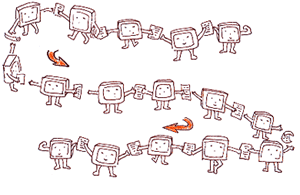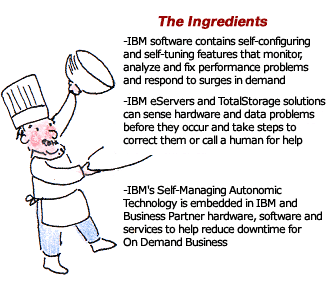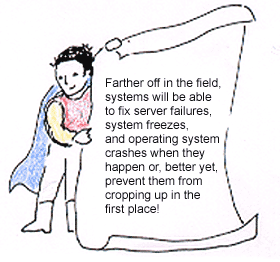How it works: Autonomic Computing
| Technology is like a race car going 200 miles per hour on the fastest track on earth. |

|
| Systems crash. People make mistakes. Computers need lots of maintenance to keep them up and running. That's life. |

|
| At the same time, businesses have become increasingly intolerant of computer failures while placing ever-greater demands on the technology they use. |

|
 Since no one is close to writing defect-free software or hardware, we need computers capable of running themselves, and with far greater levels of intelligence built right into the technology itself.
Since no one is close to writing defect-free software or hardware, we need computers capable of running themselves, and with far greater levels of intelligence built right into the technology itself.
|
And by "intelligence," we're not talking about computers that can write the next Ninth Symphony. We're talking about the same kind of intelligence we take for granted in our own bodies. |
 We walk up three flights of stairs and our heart rate increases . . .
We walk up three flights of stairs and our heart rate increases . . .
|
It's hot, we perspire . . .  |
It's cold, we shiver... |
We don't tell ourselves to do these things. They just happen. We need something similar for business.
The implications are immediately evident: A network of organized, "smart" computing components that give us what we need, when we need it, without a conscious mental or even physical effort. |
| Autonomic at work |
 |  | |||
A computer at a financial services company freezes up intermittently. |
No customer transactions are being processed for several seconds,  losing thousands of dollars in business and customer confidence and loyalty. losing thousands of dollars in business and customer confidence and loyalty. |
|||
 |  | |||
Today, IT support staff might not even find out about the problem for more  than a day; when they do, it might take a couple days to figure out what is happening. than a day; when they do, it might take a couple days to figure out what is happening. |
 With an autonomic system in place, the freeze-up is detected the first time it happens and matched against historical problem data. The settings are reset automatically, averting any real loss of revenue and customer loyalty. With an autonomic system in place, the freeze-up is detected the first time it happens and matched against historical problem data. The settings are reset automatically, averting any real loss of revenue and customer loyalty. |
|||
 | ||||
| A report that the manager reads the next day |
 |
shows the action that was taken. | ||

|  |
Want to know more? | |

|
|